Intel SSD DC P3700 Review: The PCIe SSD Transition Begins with NVMe
by Anand Lal Shimpi on June 3, 2014 2:00 AM EST- Posted in
- Storage
- SSDs
- Intel
- Intel SSD DC P3700
- NVMe
Sequential Read Performance
Sequential operations still make up a substantial portion of enterprise storage workloads. One of the most IO heavy workloads we run in AnandTech's own infrastructure are our traffic and ad stats processing routines. These tasks run daily as well as weekly and both create tremendous IO load for our database servers. Profiling the workload reveals an access pattern that's largely sequential in nature.
We'll start with a look at sequential read performance. Here we fill the drive multiple times with sequential data and then read it back for a period of 3 minutes. I'm reporting performance in MB/s as well as latency over a range of queue depths. First up, bandwidth figures:
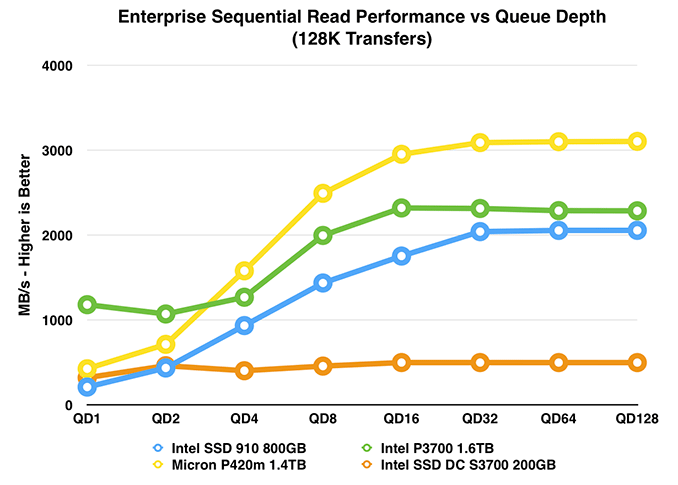
The biggest takeaway from this graph is just how much parallelism Intel manages to extract from each transfer even at a queue depth of 1. The P3700 delivers more than 1GB/s of bandwidth at QD1. That's more than double any of the other competitors here, and equal to the performance of 3.7x SATA Intel SSD DC S3700s. Note that if you force the P3700 into a higher power, 25W operating mode, Intel claims peak performance hits 2.8GB/s compared to the 2.2GB/s we show here.
With NVMe you get a direct path to the PCIe controller, and in the case of any well designed system the storage will communicate directly to a PCIe controller on the CPU's die. With a much lower overhead interface and protocol stack, the result should be substantially lower latency. The graph below looks at average
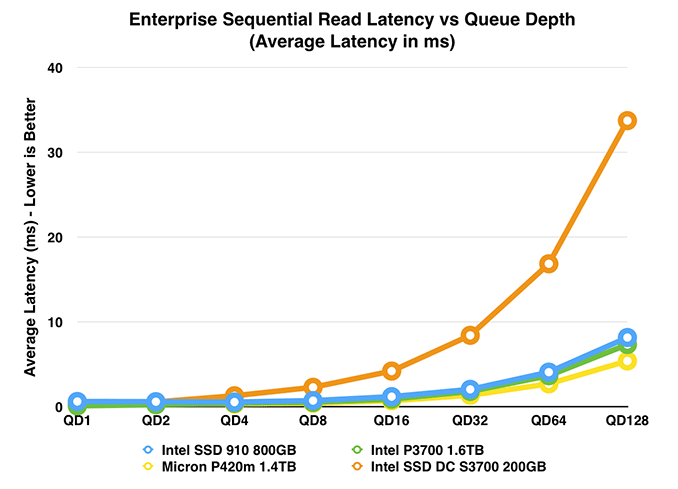
The P3700 also holds a nice latency advantage here. You'll be able to see just how low the absolute latencies are in a moment, but for now we can look at the behavior of the drives vs. queue depth. The P3700's latencies stay mostly flat up to a queue depth of 16, it's only after QD32 that we see further increased latencies. The comparison to the SATA based S3700 is hilarious. The P3700's IO latency at QD32 is lower than the S3700 at QD8.
The next graph removes the sole SATA option and looks at PCIe comparisons alone, including the native PCIe (non-NVMe) Micron P420m:
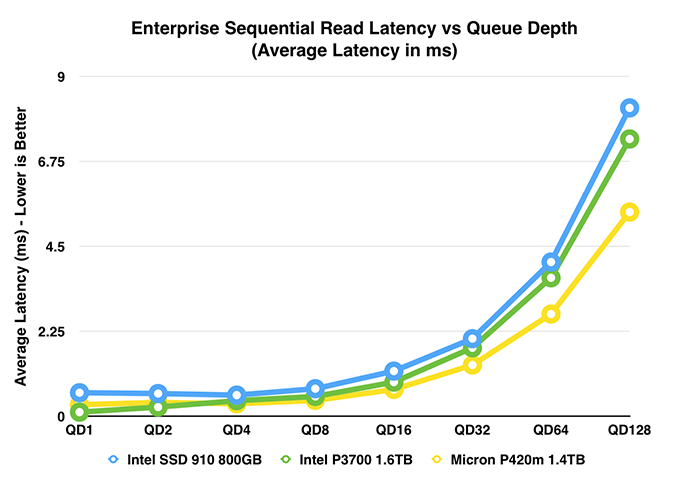
Micron definitely holds the latency advantage over Intel's design at higher queue depths. Remember that the P420m also happens to be a native PCIe SSD controller, it's just using a proprietary host controller interface.
Sequential Write Performance
Similar to our discussion around sequential read performance, sequential write performance is still a very valuable metric in the enterprise space. Large log processing can stress a drive's sequential write performance, and once again it's something we see in our own server environment.
Here we fill the drive multiple times with sequential data and then write it back for a period of 3 minutes. I'm reporting performance in MB/s as well as latency over a range of queue depths.
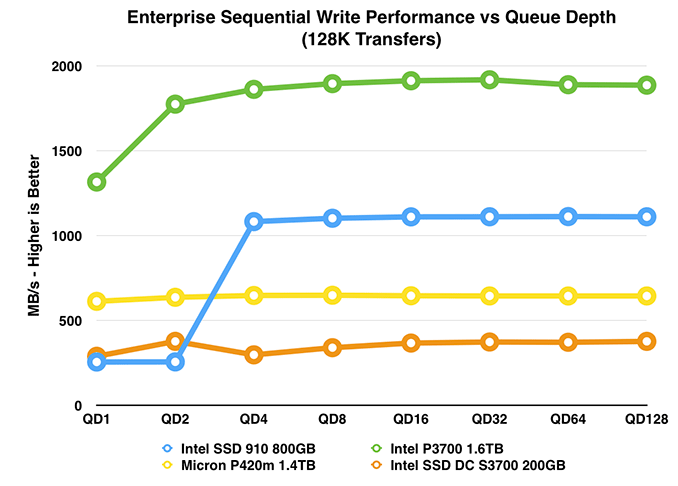
Once again we see tremendous performance at very low queue depths. At a queue depth of 1 the P3700 already performs better than any of the other drives here, and delivers 1.3GB/s of sequential write performance. That's just insane performance at such a low queue depth. By QD4, the P3700 reaches peak performance at roughly 1.9GB/s regardless of what power mode you operate it in.
The chart below shows average latency across the QD sweep:
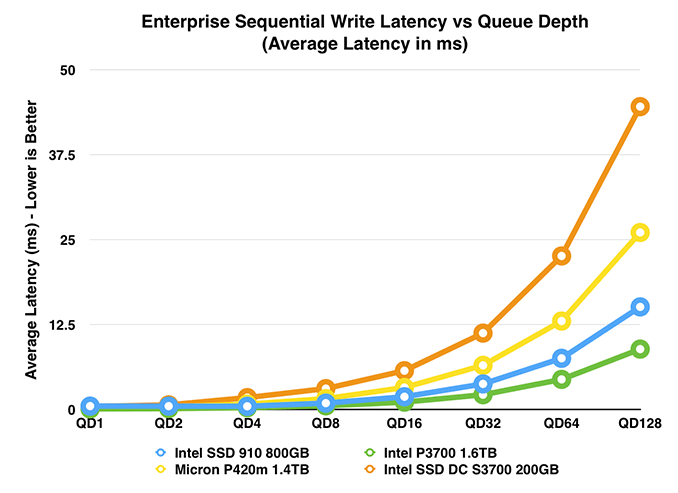
The P3700 continues to do extremely well in the latency tests, although Intel's original PCIe SSD didn't do so badly here either - its bandwidth was simply nowhere as good. Another way to look at it is that Intel now delivers better latency than the original 910, at substantially higher bandwidths. Micron's P420m manages to land somewhere between a good SATA drive and the P3700.
The next chart just removes the SATA drive so we get a better look at the PCIe comparison:
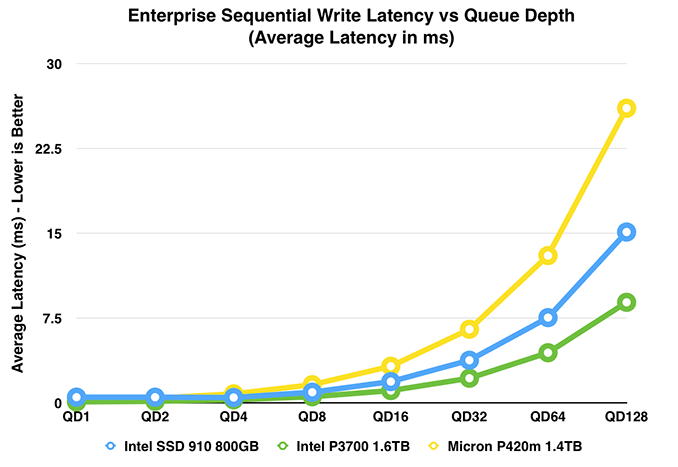










85 Comments
View All Comments
andrewaggb - Tuesday, June 3, 2014 - link
that's really the question isn't it. I'm skeptical until somebody proves otherwise. Seems like you'd need a bios update at a minimum.BeethovensCat - Tuesday, June 3, 2014 - link
Yes, this would be key. Would be annoying to buy a card and not be able to boot Windows from it. Would it be only be possible with Z97 based chipsets or also Z87? Have a relatively new Z87 card. As much as I don't want to change to Apple, one must admit they are better at getting some of these things right. Come on Intel (Asus) - make it possible to boot from one of these on a Z87 motherboard and I will buy one right away!!Taurothar - Tuesday, June 3, 2014 - link
Honestly, it's up to the motherboard's capabilities. A bios update should be possible but it depends on many things like how the PCIe lanes are distributed etc, I wouldn't count on getting the full performance out of a chipset designed before PCIe SSDs. PCIe RAID cards have the controller to boot from built in, but these stand alone SSDs mean the chipset or other onboard controller has to be able to recognize it, that might not be as simple as a bios update.morganf - Tuesday, June 3, 2014 - link
I was disappointed that the 4K QD1 read was no better than 40 MB/sec that can be achieved by SATA / AHCI SSDs like the Samsung 840 Pro.FusionIO has been getting twice that (i.e., around 80 MB/sec) for years. I was expecting NVMe to achieve something similar.
But maybe the 40 MB/sec is an OS driver limitation? Perhaps FusionIO is able to get around that because they have their own driver.
boogerlad - Tuesday, June 3, 2014 - link
Why does the p3500 have such low 4k random write IOPS? Is it merely the worst case/steady-state performance? Is it much lower quality NAND? Is it lack of over provisioning and not a problem if the drive is not filled to the brim? I've been waiting for a product like this for a very long time. To be honest, I was surprised Intel was the one to deliver. It looks like they checked out of making innovative products looking at their CPU lineup.boogerlad - Tuesday, June 3, 2014 - link
Then again, I guess as long as 4k qd1 write speeds are the same as the p3700, it doesn't really matter. Many enthusiasts will buy the p3500 and put it under a consumer workload anyways that rarely has qd > 1.Dangledon - Wednesday, June 4, 2014 - link
Low random write performance is probably an indirect reflection of TLC. The endurance numbers make this pretty clear. TLC has relatively long P/E dwell times. These times become apparent when garbage collection is triggered by sustained random write workloads. I don't know whether these devices support overprovisioning. Having it might help deal with spikey workloads as long as the "runway" is long enough. Though, frankly, the P3500 was not designed for a high random write workload.Dangledon - Wednesday, June 4, 2014 - link
My bad. They're using MLC, not TLC. The reserve/spare capacity is 7% on the P3500, which in-part accounts for the relatively low endurance. Intel is probably also doing NAND part binning, using the poorest quality parts in the P3500.rob_allshouse - Tuesday, June 3, 2014 - link
One comment (and I do work for Intel, to be open about it)... but the P3700 does this all in x4 while the p420m does it in x8, so half the PCIe lanes consumed. I didn't see this in the article, and feel like it's very relevant. It also explains the disparity in sequential read performance.mfenn - Tuesday, June 3, 2014 - link
I find it interesting that this article is presented as an enterprise SSD review and even goes so far as to decry the performance of previous implementations, but does not mention Fusion-io or Virident. We've had 500K IOPS and latencies in the tens of microseconds for years now without Intel or NVMe, those are not the stories here.NVMe is not some wonderful advance from a performance point of view, and should not be presented as such. What it is is a path towards the commoditization of relatively high performance PCIe SSDs. That's an incredibly important achievement and should have been the focus of the discussion.
As it stands, this article follows the the Intel marketing tune a little too closely and does not respect the deep market insights that I've come to expect from AnandTech.